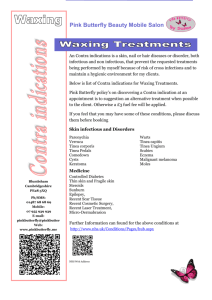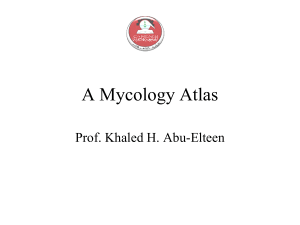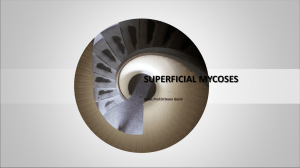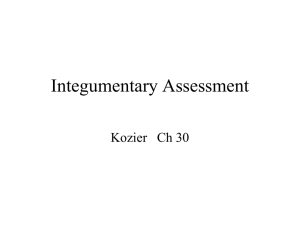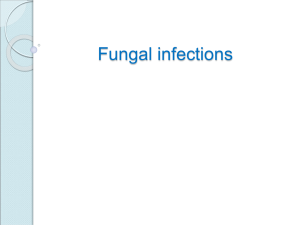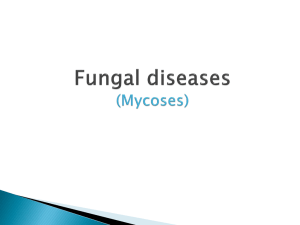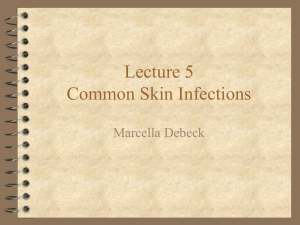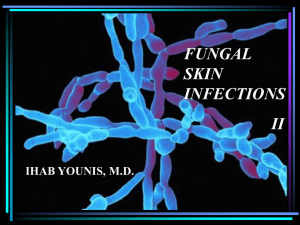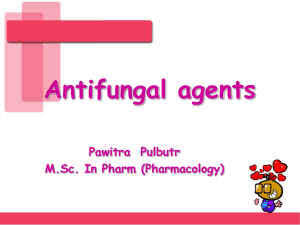Tinea Versicolor
advertisement
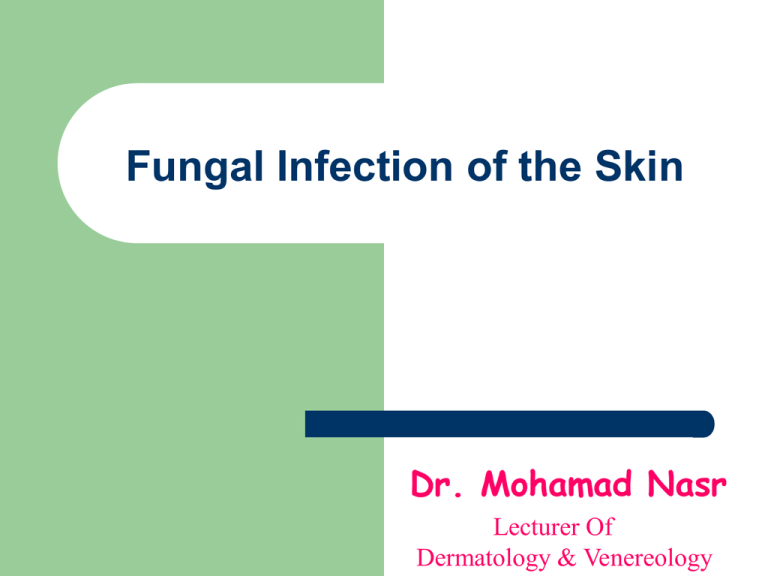
Fungal Infection of the Skin Dr. Mohamad Nasr Lecturer Of Dermatology & Venereology Topics Covered Tinea infections with special attention to scalp, feet and nails Basic diagnostic techniques – – – KOH Culture Woods light Differentials to consider. Basic Treatment Tinea Versicolor Candidiasis Dermatophytosis “Ringworm" disease of the nails, hair, and/or stratum corneum of the skin caused by fungi called dermatophytes. Etiological agents Microsporum - infections on skin and hair (not the cause of TINEA UNGUIUM) Epidermophyton - infections on skin and nails (not the cause of TINEA CAPITIS) Trichophyton - infections on skin, hair and nails. Clinical manifestations of ringworm Infections named depending on location of infection. Tinea capitis; ringworm infection of the scalp. Tinea corporis; ringworm infection of the body (smooth skin) Tinea cruris; ringworm infection of the groin. Tinea unguium; ringworm infection of the nails. Tinea barbae; ringworm infection of the beard. Tinea manuum; ringworm infection of the hand. Tinea pedis; ringworm infection of the foot (athlete's foot). Tinea corporis - body ringworm Skin lesion pink-red, scaly, annular patch with expanding border (active border). Tinea cruris - ringworm of the groin Tinea capitis - ringworm of the scalp Types: 1. Scally. Black dot. Favus. Kerion. 2. 3. 4. Scally type; Black dot type; Kerion; Favus; caused by T. schoenleinii. Tinea Capitis Treatment •Must treat hair follicle •Topical not effective •Systemic agents •Griseofulvin for children ;12.5 mg/kg. •Imidazoles, terbinafine. •Steroids for inflamed lesions like Kerion. •Treat until no visual evidence, culture (-)… plus 2 weeks •Average of 6-8 weeks of treatment. Other oral anti-fungal for patients who do not tolerate or respond to Griseofulvin. Terbinafine (Lamisil) 3 to 6mg/kg once a day for 2 to 4 weeks. Fluconazol: 6mg/kg/day once daily for 6wk Itraconazole: 5mg/kg/day,once daily or divided into two doses,for 2 to 4 weeks Tinea pedis - Athletes' foot infection Between toes or toe webs - 4th and 5th toes are the most common. Types; 1. Interdigital type. 2. Hyperkeratotic type. 3. Vesiculobullous type. Tinea Pedis: Treatment •Dry Feet •Alternate shoes, Absorbent powders, Change socks •Scale my be reduced with keratolytic •Topicals and/or Systemics. •Topical: terbinafine may be more effective than azoles. Steroids if inflamed. •Systemic allyamines or azoles Tinea Manuum Onychomycosis 15-20% of those between 40-60 yrs. infected. No Spontaneous remissions General Appearance: – – – – – – Typically begins at distal nail corner Thickening and opacification of the nail plate Nail bed hyperkeratosis Onycholysis Discoloration: white, yellow, brown Edge of the nail itself becomes severely eroded. Some or all nails may be infected Tinea unguium - ringworm of the nails Onychomycosis Types: 1. 2. Distal Subungal White superficial 3. Proximal Subungal 4. Chalky white patches May indicate HIV infection Total dystrophic Onychomycosis Onychomycosis with Onycholysis White Onychomycosis Candidaisis of nail Paronychia Psoriasis Middle of nail, oils spots, pitting. Treatment of Onychomycosis. Topical Treatment: • Can be effective for limited involvement and for prevention. Treatment of Onychomycosis Oral therapy •Effective. Relapse rate 15-20 % in one year. •Lamisil 250mg. 6 weeks/12 weeks. •Baseline labs and one month. •CBC (neutropenia), Liver function. •Itraconazole. •Pulse dosing fingernails - (200 mg bid 1 wk q mo.) x 2 Tinea Faciales Diagnostic Tests KOH Preparations – – – – – A slide. Scrape border of lesion. Apply 1-2 drops of KOH 20% and heat gently Examine at 40x Look for hyphae Fungal Cultures DTM – (Dermatophyte Test Medium) Yellow to red is (+). Sabouraud’s agar Media Wood’s Light – Tinea Capitis – Blue green florescent with M. Canis. Not useful for Trichophyton (Most Common) Other Areas: Useful to diagnose as erythrasma (coral red/pink). Tinea versicolor may be pale yellow. Less helpful if patient recently bathed. Tinea Versicolor Numerous, well-marginated, oval-to-round macules with a fine white scale when scraped. Pigmentary alteration uniform in each individual. – – – Scattered over the trunk and neck. Seldom the face. Pityrosporum orbicularis, M. furfur – Red Hypo pigmented Hyperpigmented Normal flora of skin Asymptomatic. Tinea Versicolor More apparent in the summer. Tinea Vesicolor Hyperpigmented Variety Looks Like: intertrigo, erythrasma …. Tinea Versicolor - Differential •Vitiligo •Pityriasis Alba •Pityriasis Rosea Vitiligo White without scale. Pityriasis Alba Frequently on face, KOH neg. Few lesions. May have fine white scale. Pityriasis Rosea •Papules or plaques with Collarette of scale, KOH (-), Woods light neg. Tinea Versicolor Diagnosis: •Scrape lightly – fine white scale •KOH Positive for short hyphae and spores (Spaghetti and meatballs) •Woods Light – pale yellow white fluoresce. •Culture rarely done. Tinea Vesicolor – Woods Light Yellow White Tinea Versicolor Microscope Tinea Versicolor-Treatment Topical; for limited involvement. •Selenium Sulfide Shampoos: lather 10 minutes wash off x 7 days. •Ketoconazole 2% shampoo: 5 minutes 1-3 days. •Imidazoles topicals to body qd-bid for 2-4 wks. •Terbinafine spray. Tinea Versicolor-Treatment Oral; for extensive •Itraconazole: 200 mg for 7days •Fluconazole: 300 mg once •Ketoconazole: 200 mg for 10 days Tinea Versicolor-Treatment Notes •Hypopigmentation resolves slowly •No scale when scraped indicates cure. •Sunlight helps restore pigment •Prophylaxis before summer in some patients. •Selenium shampoo’s Candidiasis •Candida Albicans •Normal Flora •Occurs in moist areas especially where skin touches. •Presentation: primary lesion is a red pustule. •Most Common: pustules dissect horizontally through the stratum corneum leaving a red, glistening denuded surface with long continuous border with satellite lesions. Candidiasis •Immunosuppression of any type (disease, steroids, D.M. or Antibiotics). •Diagnosis: History of predisposing factors and/or classic appearance of lesions at typical locations. Clinical picture; 1. 2. Oral candidiasis; thrush & perleche. Cutaneous candidiasis; – – – 3. 4. Intertrigo. Erosio-interdigitalis blastomycetica. Paronychia. Genital candidiasis; Systemic candidiasis; Thrush Angular cheilitis Intertrigo Intertrigo Erosio-interdigitalis blastomycetica Candidiasis •KOH for pseudohyphae and spores •May be impossible to tell visually from tinea. •Woods Light •Culture. •Remember yeast part of normal flora. Treatment of Candidiasis • Keep dry –powder, cotton ball between toes. • Topical – azoles. • Systemic – fluconazole; 150 mg once. Itraconazole; 200 mg bid for 1 day • Occasionally co-administration of a weak topical steroid may be helpful. • Diaper rash • Angular chelitis. THANK YOU
